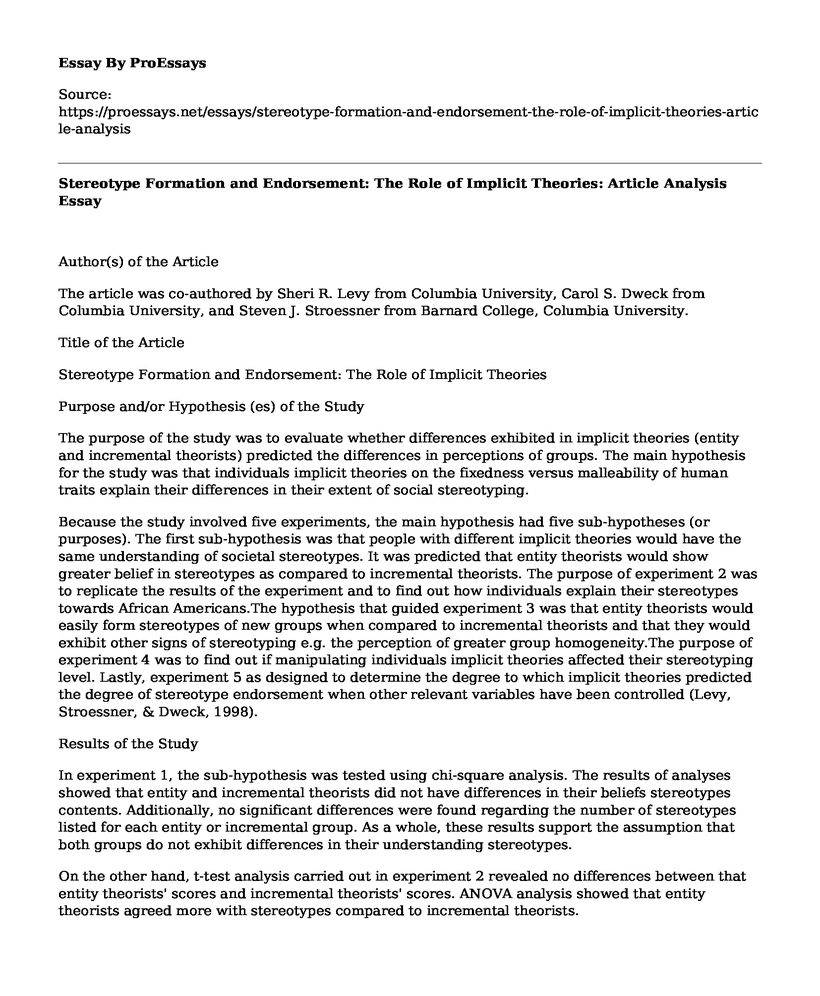Author(s) of the Article
The article was co-authored by Sheri R. Levy from Columbia University, Carol S. Dweck from Columbia University, and Steven J. Stroessner from Barnard College, Columbia University.
Title of the Article
Stereotype Formation and Endorsement: The Role of Implicit Theories
Purpose and/or Hypothesis (es) of the Study
The purpose of the study was to evaluate whether differences exhibited in implicit theories (entity and incremental theorists) predicted the differences in perceptions of groups. The main hypothesis for the study was that individuals implicit theories on the fixedness versus malleability of human traits explain their differences in their extent of social stereotyping.
Because the study involved five experiments, the main hypothesis had five sub-hypotheses (or purposes). The first sub-hypothesis was that people with different implicit theories would have the same understanding of societal stereotypes. It was predicted that entity theorists would show greater belief in stereotypes as compared to incremental theorists. The purpose of experiment 2 was to replicate the results of the experiment and to find out how individuals explain their stereotypes towards African Americans.The hypothesis that guided experiment 3 was that entity theorists would easily form stereotypes of new groups when compared to incremental theorists and that they would exhibit other signs of stereotyping e.g. the perception of greater group homogeneity.The purpose of experiment 4 was to find out if manipulating individuals implicit theories affected their stereotyping level. Lastly, experiment 5 as designed to determine the degree to which implicit theories predicted the degree of stereotype endorsement when other relevant variables have been controlled (Levy, Stroessner, & Dweck, 1998).
Results of the Study
In experiment 1, the sub-hypothesis was tested using chi-square analysis. The results of analyses showed that entity and incremental theorists did not have differences in their beliefs stereotypes contents. Additionally, no significant differences were found regarding the number of stereotypes listed for each entity or incremental group. As a whole, these results support the assumption that both groups do not exhibit differences in their understanding stereotypes.
On the other hand, t-test analysis carried out in experiment 2 revealed no differences between that entity theorists' scores and incremental theorists' scores. ANOVA analysis showed that entity theorists agreed more with stereotypes compared to incremental theorists.
The results of the ANOVAs analysis in experiment 3 showed that people having an entity theory hold more extreme judgments on relevant attributes when developing an impression of a negative or a positive group based on sparse population. Also, entity theorists make judgements faster and show greater confidence in the adequacy of evidence given for making such judgments. Results of experiment 4 indicated that entity theorists endorsed stereotypes stronger than incremental theorists. Finally results of experiment 5 revealed that implicit theories predicted differences in stereotype endorsement when other relevant variables were controlled (Levy, Stroessner, & Dweck, 1998).
Method for Testing the Hypothesis (es)
To test sub-hypothesis 1, two measures were employed. The first measure, implicit person theory measure, was domain general and consisted of three items with 6-point Likert scaling. Responses to the items were used to identify two groups of theorists (entity and incremental theorists) and a third group (those who did not have a clear implicit theory). The second measure, stereotype measure, had two sub-sections. The first sub-section measured stereotype knowledge while the second part assessed stereotype beliefs. Participants rated their beliefs on a 5-point Likert scale. Chi-square analyses, sign test, and one-way ANOVA analyses were used to test sub-hypothesis 1.To get answers for the second experiment, t-test analysis was carried out on peoples responses to Paulhus' Social Desirability Scale. Moreover, ANOVA with repeated measures analysis was used to understand the participants stereotypes on African Americans. To test the third and the fourth hypotheses, ANOVA analysis were conducted. Lastly to test the 5th hypothesis ANOVA and regression analysis were carried out (Levy, Stroessner, & Dweck, 1998).
Implications for the Results:
The differences in beliefs shown by the entity and incremental theorists regarding their explanation of group stereotypes may be related to differences in their behaviour toward groups.
Implicit theories may affect the organization and structuring of group information in memory.
Stereotyping can be reduced by altering individuals belief about the nature and source of their traits.
References
Levy, S. R., Stroessner, S. J., & Dweck, C. S. (1998). Stereotype formation and endorsement: The role of implicit theories. Journal of Personality and Social Psychology, 74(6), 1421.
Cite this page
Stereotype Formation and Endorsement: The Role of Implicit Theories: Article Analysis. (2021, Mar 13). Retrieved from https://proessays.net/essays/stereotype-formation-and-endorsement-the-role-of-implicit-theories-article-analysis
If you are the original author of this essay and no longer wish to have it published on the ProEssays website, please click below to request its removal:
- Mental Health Professional Interview on Psychology of Married Couples
- Indigenous Women in Canada Paper Example
- Research Paper on Authoritative Parenting Style
- Essay Sample on HIV Discrimination in Medical Care: A Growing Issue
- Shining Hope: Empowering Communities Through Jessica Posner & Kennedy Odede's Story - Essay Sample
- Essay Example on Women's History: Social Impact and Victorian Domesticity in the Early 1960s
- People with IDD: Equal Rights to Decision Making and Support for Health Care - Essay Example







